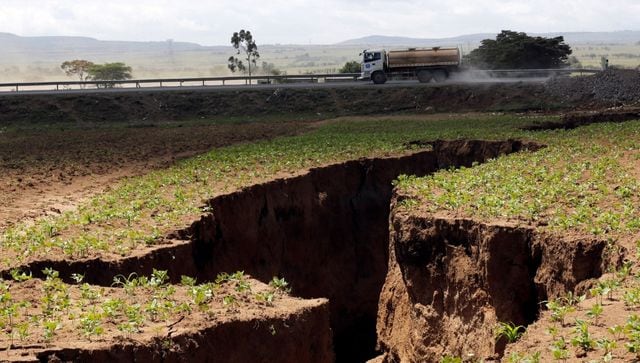
Experts believe that the continent of Africa is splitting in two and that when this happens, a new ocean will arise, giving landlocked countries a new coastline. Much research has been conducted on this topic over the years. According to the daily news source St Vincent Times, which cited research published in Geophysical Research Letters, the rift is created by processes similar to those seen at the ocean’s bottom.
The East African Rift Valley, the main branch of the East African Rift System, or the Afro-Arabian Rift System, will be the site of the continental rift. The East African Rift Valley, often known as the Great Rift Valley, extends the length of the system.
The Somali Plate, located to the east of the African Plate, is splitting from the African Plate along the East African Valley
Researchers from Syracuse University confirmed in a 2016 study published in the Journal of Structural Geology that rifting, or the process by which Earth’s tectonic plates move apart, has occurred slowly over the past 1.3 million years in the central basin of Lake Malawi, the southernmost lake in the East African Rift System. The Somali Plate, located to the east of the African Plate, is splitting from the African Plate along the East African Valley. This process has been going on for millions of years. The African continent is made up of territory from both the African and Somali plates. As a result, the African Plate region excluding the Somali Plate is also referred to as the Nubian Plate.
Along the East African Rift Valley, the Somali and Nubian plates are drifting apart. According to a 2004 study published in the journal Earth and Planetary Science Letters, the Somalian and Nubian plates are considered a single African block. The Arabian Plate is moving away from the African Plate over an active divergent ridge system, splitting the Red Sea and the Gulf of Aden. For roughly 30 million years, the Arabian Plate and the African Plate have been gently drifting apart. A diverging ridge border is generated when two tectonic plates move away from each other.
The region where the Nubian Plate, Somali Plate, and Arabian Plate meet is depicted with a Y-shaped intersection. The area is known as the Afar Triple Junction. The three tectonic plates will break at the Afar Triple Junction. (https://flathatnews.com) According to a New York Post report, the development of a new ocean will take tens of millions of years. According to an article published on the American news website Quartz, the fault lines along these tectonic plates are widening by seven centimetres per year. A new ocean basin will arise as the continent breaks into two sub-continents.
Madagascar is a long island and it will itself break apart into smaller islands
According to a 2020 study published in the journal Geology, the African continent is slowly separating into several large and small tectonic blocks along the East African Rift System, continuing to Madagascar. Madagascar is a long island just off the coast of Southeast Africa, and will itself break apart into smaller islands.
According to the Virginia Tech analysis, if this occurs, Africa and the Indian Ocean will be redefined. This glacial process of splitting is a continuation of the 200 million-year-old fracturing of the supercontinent Pangea. Sarah Stamps, the paper’s lead author, stated in a statement released by Virginia Tech that the current rate of break-up is centimetres per year, so it will be millions of years before new oceans arise. Because the rate of extension in the north is the fastest, new oceans will form there first.
The study found that the break-up process is more complex and dispersed than previously anticipated. The region of scattered extension stretches from Eastern Africa to whole parts of Madagascar, which is actively splitting apart, with southern Madagascar moving with a tiny tectonic block and a chunk of central Madagascar moving with the Somali Plate. The Lwandle microplate is a minor tectonic unit. A big crack emerged in the Kenyan Rift Valley in 2018. While many accounts claimed that the fracture was proof of the African continent actively breaking in two, The Guardian reported that the fissure was created by soil erosion induced by severe rainfall at the time.
On September 26, 2005, the Dabbahu Volcano, located along the Somali Plate, erupted, causing a massive split in the ground
On September 26, 2005, the Dabbahu Volcano, located along the Somali Plate, erupted, causing a massive split in the ground. Scientists projected that after the rift formed, the land along the region, known as the East African Rift, would eventually break away and form a new island consisting of eastern Ethiopia and Djibouti, with a new sea in between. The Dabbahu Volcano formed as a result of the Nubian Plate, Somali Plate, and Arabian Plate tectonic motions.
According to Quartz, when Africa is divided into two subcontinents, landlocked countries such as Rwanda, Burundi, Malawi, Uganda, the Democratic Republic of the Congo, and Zambia will gain access to the sea. This will aid in the construction of harbours that will immediately connect the six countries to the rest of the world.
Furthermore, the smaller segment of the East African Rift Valley, which includes Somalia, Eritrea, Djibouti, Kenya, Tanzania, Mozambique, and the eastern parts of Ethiopia, may drift away. According to the article, the remaining bigger Nubian Plate would see the creation of a coastline for several eastern and southern African countries that have traditionally relied on their neighbours for access to sea transport. The countries that get a new coastline will also have the option of immediately connecting to the subsea internet cable.
